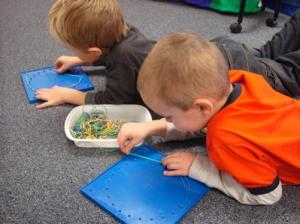Developing a Dominant Hand
At what age should my child have a “preferred” dominant hand? This is a question many parents ask. It may be helpful to understand that hand dominance may be present as early as age 3-4 but may not be fully established until age 7. Often children at the preschool age are still experimenting with use of both hands. It is important to let this process develop naturally so that dominance can emerge on its own without adult interference. Look for a preference during mealtimes when using utensils, which hand the child starts with to pick up a crayon when coloring, as well as hand preference during gross motor play such as throwing a ball. Once a clear preference has been determined, it is ok to encourage your child to use that preferred hand when coloring or drawing. If after several minutes, they switch hands, encourage them to give their hand a brief rest (“shake, shake, shake, take a break”), then resume coloring with their dominant hand. During less structured play time, use of either or both hands is natural and should not be discouraged.
There are three developmental stages that help a child to develop hand dominance. These stages include:
•Symmetrical bilateral integration – using both arms/hands to perform the same action at the same time such as pushing, pulling, clapping, etc.
•Reciprocal bilateral integration – when one arm is doing the exact opposite of the other arm such as when crawling, or when the arms swing when walking, climbing, etc.
•Asymmetrical Bilateral Integration – when the arms/hands are performing two different actions at the same time such as when stringing beads, screwing nuts and bolts, lacing string, etc. This stage is the beginning of one hand learning to be more of the “helper hand” and one hand becoming more of the “worker or dominant hand”.
Typically children will progress through these three stages of development, naturally, as they mature, over time. Occasionally, however, a child may be delayed in passing through one of these stages due to issues other than just maturity. One reason is that some children may not have enough upper body strength yet to sustain use of just one hand. In these cases, the child likely tends to switch hands continuously when engaged in a task such as coloring due to fatigue or limited endurance. In addition to hand strengthening (see my last blog post for ideas :)….it is equally important to ensure the child has adequate proximal stability and upper body strength. A few fun ideas to help improve proximal stability and upper body strength include:
- “animal walks”- crab walk, bear walk or wheelbarrow walking (all of which require weight bearing through the arms)
- Prone on elbows positioning (laying on belly, propped by elbows) during floor play.
- Wall push-ups- stabilize the feet approx. 18” from wall, position hands on wall at shoulder height and shoulder width apart, then complete sets of at least 12 “push ups” against the wall.
